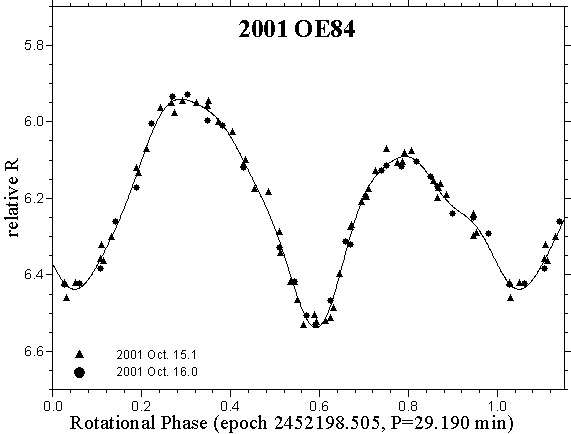This Amor asteroid has been observed by P. Kusnirak and P. Pravec on two nights of 2001 Oct. 15.1 and 16.0. The observations revealed a synodic rotation period of (29.190 +/- 0.002) min. The rotation is so fast that the object cannot be held together by self-gravitation and it is a body with a non-zero tensile strength (see Pravec et al. 2000, Pravec and Harris 2000). The composite lightcurve ( Fig. 1) has an amplitude of 0.60 mag (at phase angle 25 deg) that indicates an elongated figure with equatorial axis ratio > = 1.4.
Figure 2 shows the observed lightcurve of the second observational night. A sampling was one point per 140 seconds during most of the time (130-sec integration time plus a 10-sec readout), therefore consecutive points fall on fairly different rotation phases.
Figure 3 shows spin rate vs diameter plot for 987 asteroids of all sizes (updated from Pravec et al. 2001). With its estimated size of about 0.9 km (using H=17.7 from MPEC 2001-U02 and assuming a geometric albedo of 0.18 typical for near-Earth asteroids), 2001 OE84 is an exceptional object - all other known superfast monolithic rotators are objects less than about 0.15 km diameter. All other asteroids greater than ~0.15 km with known periods are below the critical rotation "barrier" of 12 rev/day (period > 2 h) that is an evidence that most of them are strengthless objects, so-called "rubble piles" (e.g., Pravec and Harris 2000). 2001 OE84 is the largest known asteroid with significant tensile strength, the first known in the km size range. It is an evidence that coherent bodies exist also among asteroids as large as ~1 km.


